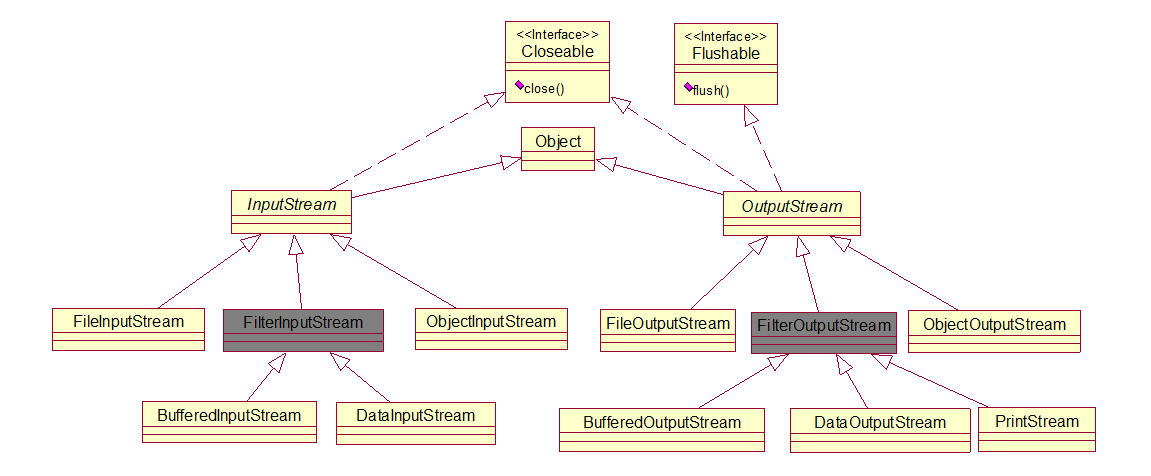
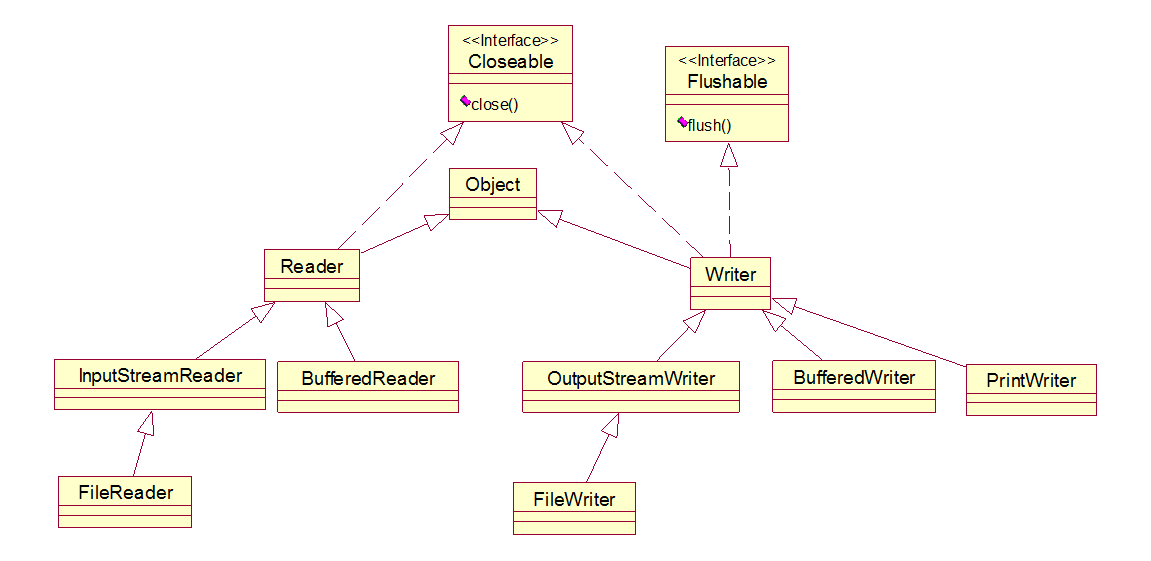
File类介绍
File类的构造方法
| 方法名 | 说明 |
|---|---|
| File(String pathname) | 通过将给定的路径名字符串转换为抽象路径名来创建新的 File实例 |
| File(String parent, String child) | 从父路径名字符串和子路径名字符串创建新的 File实例 |
| File(File parent, String child) | 从父抽象路径名和子路径名字符串创建新的 File实例 |
示例代码
public class FileDemo01 {
public static void main(String[] args) {
//File(String pathname): 通过将给定的路径名字符串转换为抽象路径名来创建新的 File实例
File f1 = new File("E:\\itcast\\java.txt");
System.out.println(f1);
//File(String parent, String child): 从父路径名字符串和子路径名字符串创建新的 File实例
File f2 = new File("E:\\itcast","java.txt");
System.out.println(f2);
//File(File parent, String child): 从父抽象路径名和子路径名字符串创建新的 File实例
File f3 = new File("E:\\itcast");
File f4 = new File(f3,"java.txt");
System.out.println(f4);
}
}
绝对路径
是一个完整的路径,从盘符开始
相对路径
是一个简化的路径,相对当前项目下的路径
示例代码
public class FileDemo02 {
public static void main(String[] args) {
// 是一个完整的路径,从盘符开始
File file1 = new File("D:\\itcast\\a.txt");
// 是一个简化的路径,从当前项目根目录开始
File file2 = new File("a.txt");
File file3 = new File("模块名\\a.txt");
}
}
方法分类
| 方法名 | 说明 |
|---|---|
| public boolean createNewFile() | 当具有该名称的文件不存在时,创建一个由该抽象路径名命名的新空文件。若存在该名称的文件则返回false。 不管调用者有没有后缀名,只能创建文件 |
| public boolean mkdir() | 创建由此抽象路径名命名的目录 只能重建单级文件夹,不能创建多级文件夹 不管有没有后缀名,只能创建单级文件夹(一般不用该方法,mkdirs可以代替) |
| public boolean mkdirs() | 创建由此抽象路径名命名的目录,包括任何必需但不存在的父目录 创建一个多级文件夹 也可以创建一个单级文件夹 |
示例代码
public class FileDemo02 {
public static void main(String[] args) throws IOException {
//需求1:我要在E:\\itcast目录下创建一个文件java.txt
File f1 = new File("E:\\itcast\\java.txt");
System.out.println(f1.createNewFile());
System.out.println("--------");
//需求2:我要在E:\\itcast目录下创建一个目录JavaSE
File f2 = new File("E:\\itcast\\JavaSE");
System.out.println(f2.mkdir());
System.out.println("--------");
//需求3:我要在E:\\itcast目录下创建一个多级目录JavaWEB\\HTML
File f3 = new File("E:\\itcast\\JavaWEB\\HTML");
// System.out.println(f3.mkdir());
System.out.println(f3.mkdirs());
System.out.println("--------");
//需求4:我要在E:\\itcast目录下创建一个文件javase.txt
File f4 = new File("E:\\itcast\\javase.txt");
// System.out.println(f4.mkdir());
System.out.println(f4.createNewFile());
}
}
方法分类
| 方法名 | 说明 |
|---|---|
| public boolean delete() | 删除由此抽象路径名表示的文件或目录,删除的文件不进入回收站 如果删除的是文件,那么直接删除;如果删除的是文件夹,那么只能删除空文件夹 如果要删除一个有内容的文件夹,只能先进入该文件夹中,把里面的内容删除完毕才能再次删除这个文件夹 简单来说:只能删除文件和空文件夹 |
示例代码
public class FileDemo03 {
public static void main(String[] args) throws IOException {
// File f1 = new File("E:\\itcast\\java.txt");
//需求1:在当前模块目录下创建java.txt文件
File f1 = new File("myFile\\java.txt");
// System.out.println(f1.createNewFile());
//需求2:删除当前模块目录下的java.txt文件
System.out.println(f1.delete());
System.out.println("--------");
//需求3:在当前模块目录下创建itcast目录
File f2 = new File("myFile\\itcast");
// System.out.println(f2.mkdir());
//需求4:删除当前模块目录下的itcast目录
System.out.println(f2.delete());
System.out.println("--------");
//需求5:在当前模块下创建一个目录itcast,然后在该目录下创建一个文件java.txt
File f3 = new File("myFile\\itcast");
// System.out.println(f3.mkdir());
File f4 = new File("myFile\\itcast\\java.txt");
// System.out.println(f4.createNewFile());
//需求6:删除当前模块下的目录itcast
System.out.println(f4.delete());
System.out.println(f3.delete());
}
}
判断功能
| 方法名 | 说明 |
|---|---|
| public boolean isDirectory() | 测试此抽象路径名表示的File是否为目录 |
| public boolean isFile() | 测试此抽象路径名表示的File是否为文件 |
| public boolean exists() | 测试此抽象路径名表示的File是否存在 |
获取功能
| 方法名 | 说明 |
|---|---|
| public String getAbsolutePath() | 返回此抽象路径名的绝对路径名字符串 |
| public String getPath() | 将此抽象路径名转换为路径名字符串 |
| public String getName() | 返回由此抽象路径名表示的文件或目录的名称 如果调用者是文件,那么获取的是文件名和后缀名 如果调用者是一个文件夹,那么获取的是文件夹的名字 |
| public File[] listFiles() | 返回此抽象路径名表示的目录中的文件和目录的File对象数组(包括隐藏文件和隐藏文件夹)  |
示例代码
public class FileDemo04 {
public static void main(String[] args) {
//创建一个File对象
File f = new File("myFile\\java.txt");
// public boolean isDirectory():测试此抽象路径名表示的File是否为目录
// public boolean isFile():测试此抽象路径名表示的File是否为文件
// public boolean exists():测试此抽象路径名表示的File是否存在
System.out.println(f.isDirectory());
System.out.println(f.isFile());
System.out.println(f.exists());
// public String getAbsolutePath():返回此抽象路径名的绝对路径名字符串
// public String getPath():将此抽象路径名转换为路径名字符串
// public String getName():返回由此抽象路径名表示的文件或目录的名称
System.out.println(f.getAbsolutePath());
System.out.println(f.getPath());
System.out.println(f.getName());
System.out.println("--------");
// public File[] listFiles():返回此抽象路径名表示的目录中的文件和目录的File对象数组
File f2 = new File("E:\\itcast");
File[] fileArray = f2.listFiles();
for(File file : fileArray) {
// System.out.println(file);
// System.out.println(file.getName());
if(file.isFile()) {
System.out.println(file.getName());
}
}
}
}
案例需求
在当前模块下的aaa文件夹中创建一个a.txt文件
实现步骤
代码实现
public class Test1 {
public static void main(String[] args) throws IOException {
//练习一:在当前模块下的aaa文件夹中创建一个a.txt文件
/* File file = new File("filemodule\\aaa\\a.txt");
file.createNewFile();*/
//注意点:文件所在的文件夹必须要存在.
//1.创建File对象,指向aaa文件夹
File file = new File("filemodule\\aaa");
//2.判断aaa文件夹是否存在,如果不存在则创建
if(!file.exists()){
//如果文件夹不存在,就创建出来
file.mkdirs();
}
//3.创建File对象,指向aaa文件夹下的a.txt文件
File newFile = new File(file,"a.txt");
//4.创建这个文件
newFile.createNewFile();
}
}
案例需求
删除一个多级文件夹
实现步骤
代码实现
public class Test2 {
public static void main(String[] args) {
//练习二:删除一个多级文件夹
//delete方法
//只能删除文件和空文件夹.
//如果现在要删除一个有内容的文件夹?
//先删掉这个文件夹里面所有的内容.
//最后再删除这个文件夹
File src = new File("C:\\Users\\apple\\Desktop\\src");
deleteDir(src);
}
//1.定义一个方法,接收一个File对象
private static void deleteDir(File src) {
//先删掉这个文件夹里面所有的内容.
//递归 方法在方法体中自己调用自己.
//注意: 可以解决所有文件夹和递归相结合的题目
//2.遍历这个File对象,获取它下边的每个文件和文件夹对象
File[] files = src.listFiles();
//3.判断当前遍历到的File对象是文件还是文件夹
for (File file : files) {
//4.如果是文件,直接删除
if(file.isFile()){
file.delete();
}else{
//5.如果是文件夹,递归调用自己,将当前遍历到的File对象当做参数传递
deleteDir(file);//参数一定要是src文件夹里面的文件夹File对象
}
}
//6.参数传递过来的文件夹File对象已经处理完成,最后直接删除这个空文件夹
src.delete(); //这一步必须放在函数里参与递归,把每一个空文件夹删除
}
}
案例需求
统计一个文件夹中每种文件的个数并打印
打印格式如下:
txt:3个
doc:4个
jpg:6个
…
实现步骤
代码实现
public class Test3 {
public static void main(String[] args) {
//统计一个文件夹中,每种文件出现的次数.
//统计 --- 定义一个变量用来统计. ---- 弊端:同时只能统计一种文件
//利用map集合进行数据统计,键 --- 文件后缀名 值 ---- 次数
File file = new File("filemodule");
HashMap<String, Integer> hm = new HashMap<>();
getCount(hm, file);
System.out.println(hm);
}
//1.定义一个方法,参数是HashMap集合用来统计次数和File对象要统计的文件夹
private static void getCount(HashMap<String, Integer> hm, File file) {
//2.遍历File对象,获取它下边的每一个文件和文件夹对象
File[] files = file.listFiles();
for (File f : files) {
//3.判断当前File对象是文件还是文件夹
if(f.isFile()){
//如果是文件,判断这种类型文件后缀名在HashMap集合中是否出现过
String fileName = f.getName();
String[] fileNameArr = fileName.split("\\.");
if(fileNameArr.length == 2){
String fileEndName = fileNameArr[1];
if(hm.containsKey(fileEndName)){
//出现过,获取这种类型文件的后缀名出现的次数,对其+1,在存回集合中
Integer count = hm.get(fileEndName);
//这种文件又出现了一次.
count++;
//把已经出现的次数给覆盖掉.
hm.put(fileEndName,count);
}else{
// 没出现过,将这种类型文件的后缀名存入集合中,次数存1
hm.put(fileEndName,1);
}
}
}else{
//如果是文件夹,递归调用自己,HashMap集合就是参数集合,File对象是当前文件夹对象代码实现
getCount(hm,f);
}
}
}
}
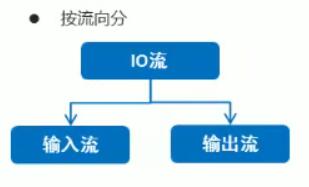
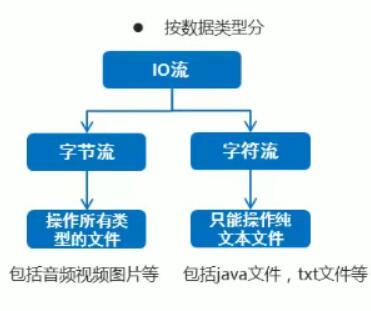
字节流抽象基类
字节输出流
使用字节输出流写数据的步骤
示例代码
public class FileOutputStreamDemo01 {
public static void main(String[] args) throws IOException {
//创建字节输出流对象
/*
注意点:
1.如果文件不存在,会帮我们创建
2.如果文件存在,会把文件清空
*/
//FileOutputStream(String name):创建文件输出流以指定的名称写入文件
FileOutputStream fos = new FileOutputStream("myByteStream\\fos.txt");
//void write(int b):将指定的字节写入此文件输出流
fos.write(97);
// fos.write(57);
// fos.write(55);
//最后都要释放资源
//void close():关闭此文件输出流并释放与此流相关联的任何系统资源。
fos.close();
}
}
写数据的方法分类
| 方法名 | 说明 |
|---|---|
| void write(int b) | 将指定的字节写入此文件输出流 一次写一个字节数据 |
| void write(byte[] b) | 将 b.length字节从指定的字节数组写入此文件输出流 一次写一个字节数组数据 |
| void write(byte[] b, int off, int len) | 将 len字节从指定的字节数组开始,从偏移量off开始写入此文件输出流 一次写一个字节数组的部分数据 |
示例代码
public class FileOutputStreamDemo02 {
public static void main(String[] args) throws IOException {
//FileOutputStream(String name):创建文件输出流以指定的名称写入文件
FileOutputStream fos = new FileOutputStream("myByteStream\\fos.txt");
//FileOutputStream(File file):创建文件输出流以写入由指定的 File对象表示的文件
// FileOutputStream fos = new FileOutputStream(new File("myByteStream\\fos.txt"));
//void write(int b):将指定的字节写入此文件输出流
// fos.write(97);
// fos.write(98);
// fos.write(99);
// fos.write(100);
// fos.write(101);
// void write(byte[] b):将 b.length字节从指定的字节数组写入此文件输出流
// byte[] bys = {97, 98, 99, 100, 101};
//byte[] getBytes():返回字符串对应的字节数组
byte[] bys = "abcde".getBytes();
// fos.write(bys);
//void write(byte[] b, int off, int len):将 len字节从指定的字节数组开始,从偏移量off开始写入此文件输出流
// fos.write(bys,0,bys.length);
fos.write(bys,1,3);
//释放资源
fos.close();
}
}
字节流写数据如何实现换行
windows:\r\nlinux:\nmac:\r字节流写数据如何实现追加写入
public FileOutputStream(String name,boolean append)示例代码
public class FileOutputStreamDemo03 {
public static void main(String[] args) throws IOException {
//创建字节输出流对象
// FileOutputStream fos = new FileOutputStream("myByteStream\\fos.txt");
FileOutputStream fos = new FileOutputStream("myByteStream\\fos.txt",true);
//写数据
for (int i = 0; i < 10; i++) {
fos.write("hello".getBytes());
fos.write("\r\n".getBytes());
}
//释放资源
fos.close();
}
}
异常处理格式
try-catch-finally
try{
可能出现异常的代码;
}catch(异常类名 变量名){
异常的处理代码;
}finally{
执行所有清除操作;
}
finally特点
示例代码
public class FileOutputStreamDemo04 {
public static void main(String[] args) {
//加入finally来实现释放资源
FileOutputStream fos = null;
try {
fos = new FileOutputStream("myByteStream\\fos.txt");
fos.write("hello".getBytes());
} catch (IOException e) {
e.printStackTrace();
} finally {
if(fos != null) {
try {
fos.close();
} catch (IOException e) {
e.printStackTrace();
}
}
}
}
}
字节输入流
字节输入流读取数据的步骤
示例代码
public class FileInputStreamDemo01 {
public static void main(String[] args) throws IOException {
//创建字节输入流对象
//FileInputStream(String name)
FileInputStream fis = new FileInputStream("myByteStream\\fos.txt");
int by;
/*
fis.read():读数据
by=fis.read():把读取到的数据赋值给by
by != -1:判断读取到的数据是否是-1
*/
while ((by=fis.read())!=-1) {
System.out.print((char)by);
}
//释放资源
fis.close();
}
}
案例需求
? 把“E:\itcast\窗里窗外.txt”复制到模块目录下的“窗里窗外.txt” (文件可以是任意文件)
实现步骤
复制文本文件,其实就把文本文件的内容从一个文件中读取出来(数据源),然后写入到另一个文件中(目的地)
数据源:
? E:\itcast\窗里窗外.txt --- 读数据 --- InputStream --- FileInputStream
目的地:
? myByteStream\窗里窗外.txt --- 写数据 --- OutputStream --- FileOutputStream
代码实现
public class CopyTxtDemo {
public static void main(String[] args) throws IOException {
//根据数据源创建字节输入流对象
FileInputStream fis = new FileInputStream("E:\\itcast\\窗里窗外.txt");
//根据目的地创建字节输出流对象
FileOutputStream fos = new FileOutputStream("myByteStream\\窗里窗外.txt");
//读写数据,复制文本文件(一次读取一个字节,一次写入一个字节)
int by;
while ((by=fis.read())!=-1) { //(by=fis.read())小括号别忘了
fos.write(by);
}
//释放资源
fos.close();
fis.close();
}
}
一次读一个字节数组的方法
public int read(byte[] b):从输入流读取最多b.length个字节的数据示例代码
public class FileInputStreamDemo02 {
public static void main(String[] args) throws IOException {
//创建字节输入流对象
FileInputStream fis = new FileInputStream("myByteStream\\fos.txt");
byte[] bys = new byte[1024]; //1024及其整数倍
int len; //len表示一次读取到的有效字节数量
//循环读取
while ((len=fis.read(bys))!=-1) {
System.out.print(new String(bys,0,len));
}
//释放资源
fis.close();
}
}
案例需求
? 把“E:\itcast\mn.jpg”复制到模块目录下的“mn.jpg” (文件可以是任意文件去)
实现步骤
代码实现
public class CopyJpgDemo {
public static void main(String[] args) throws IOException {
//根据数据源创建字节输入流对象
FileInputStream fis = new FileInputStream("E:\\itcast\\mn.jpg");
//根据目的地创建字节输出流对象
FileOutputStream fos = new FileOutputStream("myByteStream\\mn.jpg");
//读写数据,复制图片(一次读取一个字节数组,一次写入一个字节数组)
byte[] bys = new byte[1024];
int len;
while ((len=fis.read(bys))!=-1) {
fos.write(bys,0,len);
}
//释放资源
fos.close();
fis.close();
}
}
字节缓冲流介绍
构造方法:
| 方法名 | 说明 |
|---|---|
| BufferedOutputStream(OutputStream out) | 创建字节缓冲输出流对象 |
| BufferedInputStream(InputStream in) | 创建字节缓冲输入流对象 |
底层原理
一次读取一个字节
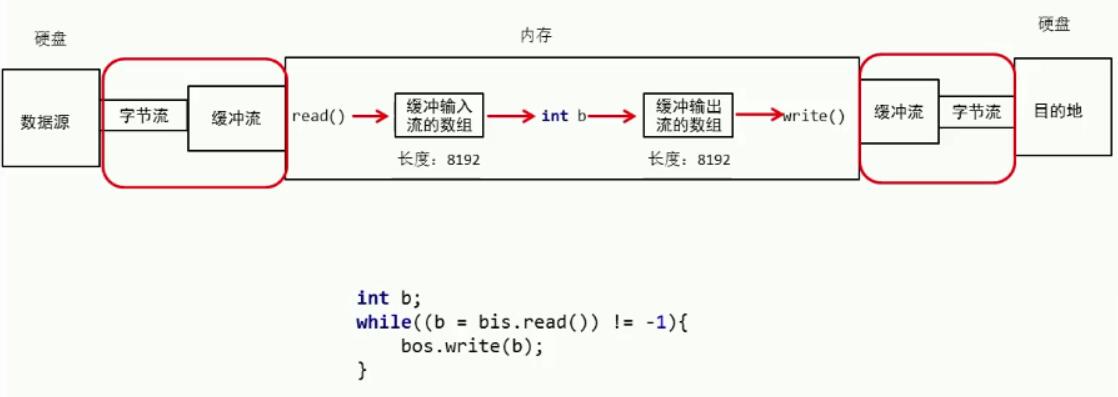
一次读取一个字节数组
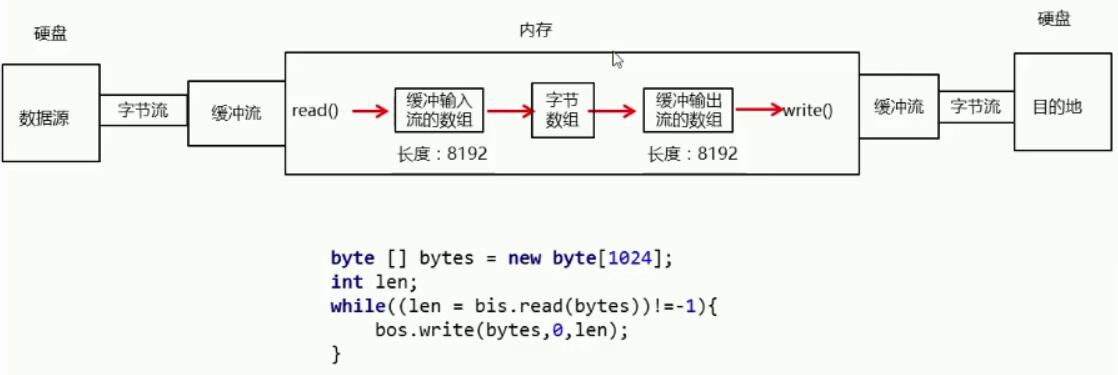
创建了一个大小为8192字节的缓冲数组,减少了硬盘与内存之间数据传递的次数,提高效率。
示例代码
public class BufferStreamDemo {
public static void main(String[] args) throws IOException {
//字节缓冲输出流:BufferedOutputStream(OutputStream out)
//缓冲流也叫包装流(处理流),FileOutputStream叫节点流
BufferedOutputStream bos = new BufferedOutputStream(new FileOutputStream("myByteStream\\bos.txt"));
//写数据
bos.write("hello\r\n".getBytes());
bos.write("world\r\n".getBytes());
//释放资源
bos.close();
//字节缓冲输入流:BufferedInputStream(InputStream in)
BufferedInputStream bis = new BufferedInputStream(new FileInputStream("myByteStream\\bos.txt"));
//一次读取一个字节数据
// int by;
// while ((by=bis.read())!=-1) {
// System.out.print((char)by);
// }
//一次读取一个字节数组数据
byte[] bys = new byte[1024];
int len;
while ((len=bis.read(bys))!=-1) {
System.out.print(new String(bys,0,len));
}
//释放资源
bis.close(); //包装流关闭,节点流自动关闭
/* 源码如下
public void close() throws IOException {
byte[] buffer;
while ( (buffer = buf) != null) {
if (U.compareAndSetReference(this, BUF_OFFSET, buffer, null)) {
InputStream input = in;
in = null;
if (input != null) //关闭节点流
input.close();
return;
}
// Else retry in case a new buf was CASed in fill()
}
}*/
}
}
案例需求
把“E:\itcast\字节流复制图片.avi”复制到模块目录下的“字节流复制图片.avi”
实现步骤
代码实现
public class CopyAviDemo {
public static void main(String[] args) throws IOException {
//复制视频
// method1();
method2();
}
//字节缓冲流一次读写一个字节数组
public static void method2() throws IOException {
BufferedInputStream bis = new BufferedInputStream(new FileInputStream("E:\\itcast\\字节流复制图片.avi"));
BufferedOutputStream bos = new BufferedOutputStream(new FileOutputStream("myByteStream\\字节流复制图片.avi"));
byte[] bys = new byte[1024];
int len;
while ((len=bis.read(bys))!=-1) {
bos.write(bys,0,len);
}
bos.close();
bis.close();
}
//字节缓冲流一次读写一个字节
public static void method1() throws IOException {
BufferedInputStream bis = new BufferedInputStream(new FileInputStream("E:\\itcast\\字节流复制图片.avi"));
BufferedOutputStream bos = new BufferedOutputStream(new FileOutputStream("myByteStream\\字节流复制图片.avi"));
int by;
while ((by=bis.read())!=-1) {
bos.write(by);
}
bos.close();
bis.close();
}
}
字符流的介绍
由于字节流操作中文不是特别的方便,所以Java就提供字符流
字符流 = 字节流 + 编码表
中文的字节存储方式
用字节流复制文本文件时,文本文件也会有中文,但是没有问题,原因是最终底层操作会自动进行字节拼接成中文,如何识别是中文的呢?
汉字在存储的时候,无论选择哪种编码存储,第一个字节都是负数

什么是字符集
是一个系统支持的所有字符的集合,包括各国家文字、标点符号、图形符号、数字等
l计算机要准确的存储和识别各种字符集符号,就需要进行字符编码,一套字符集必然至少有一套字符编码。常见字符集有ASCII字符集、GBXXX字符集、Unicode字符集等
常见的字符集
ASCII字符集:
lASCII:是基于拉丁字母的一套电脑编码系统,用于显示现代英语,主要包括控制字符(回车键、退格、换行键等)和可显示字符(英文大小写字符、阿拉伯数字和西文符号)
基本的ASCII字符集,使用7位表示一个字符,共128字符。ASCII的扩展字符集使用8位表示一个字符,共256字符,方便支持欧洲常用字符。是一个系统支持的所有字符的集合,包括各国家文字、标点符号、图形符号、数字等
GBXXX字符集:
GBK:最常用的中文码表。是在GB2312标准基础上的扩展规范,使用了双字节编码方案,共收录了21003个汉字,完全兼容GB2312标准,同时支持繁体汉字以及日韩汉字等.
注意GBK编码以后一个中文以两个字节的形式存储。
Windows默认使用GBK
Unicode字符集:
UTF-8编码:可以用来表示Unicode标准中任意字符,它是电子邮件、网页及其他存储或传送文字的应用 中,优先采用的编码。互联网工程工作小组(IETF)要求所有互联网协议都必须支持UTF-8编码。它使用一至四个字节为每个字符编码。注意UTF-8编码以后一个中文以三个字节的形式存储
编码规则:
128个US-ASCII字符,只需一个字节编码
拉丁文等字符,需要二个字节编码
大部分常用字(含中文),使用三个字节编码
其他极少使用的Unicode辅助字符,使用四字节编码
相关方法
| 方法名 | 说明 |
|---|---|
| byte[] getBytes() | 使用平台的默认字符集将该 String编码为一系列字节 |
| byte[] getBytes(String charsetName) | 使用指定的字符集将该 String编码为一系列字节 |
| String(byte[] bytes) | 使用平台的默认字符集解码指定的字节数组来创建字符串 |
| String(byte[] bytes, String charsetName) | 通过指定的字符集解码指定的字节数组来创建字符串 |
代码演示
public class StringDemo {
public static void main(String[] args) throws UnsupportedEncodingException {
//定义一个字符串
String s = "中国";
//byte[] bys = s.getBytes(); //[-28, -72, -83, -27, -101, -67]
//byte[] bys = s.getBytes("UTF-8"); //[-28, -72, -83, -27, -101, -67]
byte[] bys = s.getBytes("GBK"); //[-42, -48, -71, -6]
System.out.println(Arrays.toString(bys));
//String ss = new String(bys);
//String ss = new String(bys,"UTF-8");
String ss = new String(bys,"GBK");
System.out.println(ss);
}
}
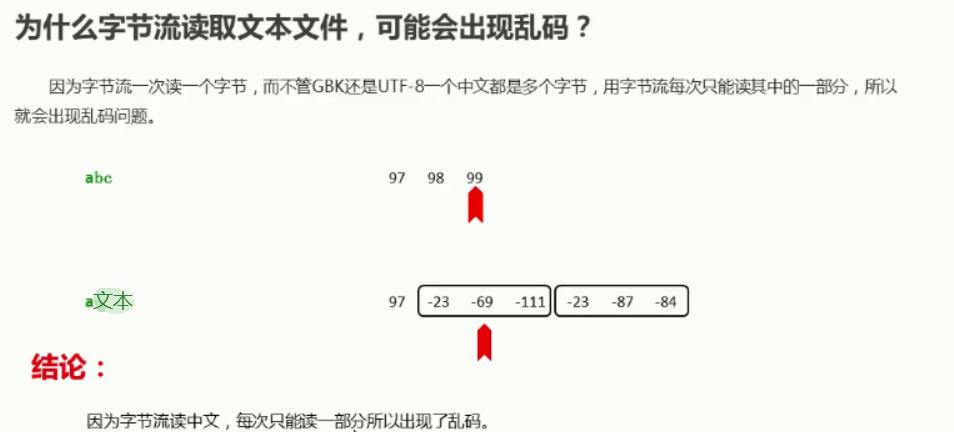
介绍
Writer: 用于写入字符流的抽象父类
FileWriter: 用于写入字符流的常用子类
构造方法
| 方法名 | 说明 |
|---|---|
| FileWriter(File file) | 根据给定的 File 对象构造一个 FileWriter 对象 |
| FileWriter(File file, boolean append) | 根据给定的 File 对象构造一个 FileWriter 对象 |
| FileWriter(String fileName) | 根据给定的文件名构造一个 FileWriter 对象 |
| FileWriter(String fileName, boolean append) | 根据给定的文件名以及指示是否附加写入数据的 boolean 值来构造 FileWriter 对象 |
成员方法
| 方法名 | 说明 |
|---|---|
| void write(int c) | 写一个字符 |
| void write(char[] cbuf) | 写入一个字符数组 |
| void write(char[] cbuf, int off, int len) | 写入字符数组的一部分 |
| void write(String str) | 写一个字符串 |
| void write(String str, int off, int len) | 写一个字符串的一部分 |
刷新和关闭的方法
| 方法名 | 说明 |
|---|---|
| flush() | 刷新流,之后还可以继续写数据 |
| close() | 关闭流,释放资源,但是在关闭之前会先刷新流。一旦关闭,就不能再写数据 |
注意事项
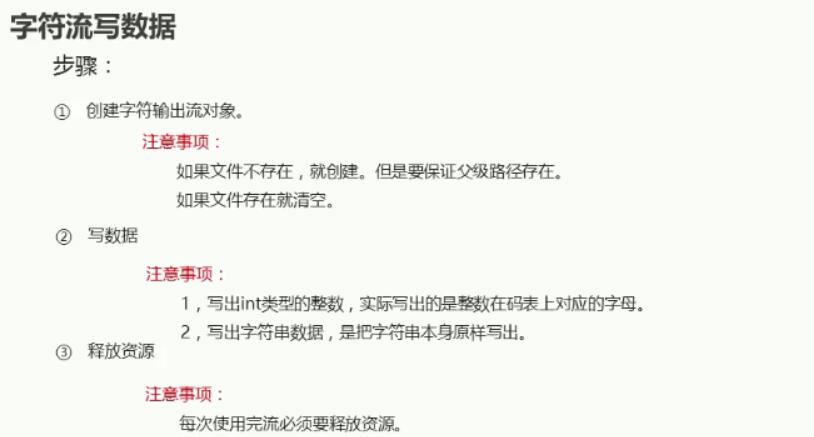
代码演示
public class OutputStreamWriterDemo {
public static void main(String[] args) throws IOException {
//创建字符输出流对象
FileWriter fw = new FileWriter("myCharStream\\a.txt");
//void write(int c):写一个字符
// fw.write(97);
// fw.write(98);
// fw.write(99);
//void writ(char[] cbuf):写入一个字符数组
char[] chs = {‘a‘, ‘b‘, ‘c‘, ‘d‘, ‘e‘};
// fw.write(chs);
//void write(char[] cbuf, int off, int len):写入字符数组的一部分
// fw.write(chs, 0, chs.length);
// fw.write(chs, 1, 3);
//void write(String str):写一个字符串
// fw.write("abcde");
//void write(String str, int off, int len):写一个字符串的一部分
// fw.write("abcde", 0, "abcde".length());
fw.write("abcde", 1, 3);
//释放资源
fw.close();
}
}
介绍
Reader: 用于读取字符流的抽象父类
FileReader: 用于读取字符流的常用子类
构造方法
| 方法名 | 说明 |
|---|---|
| FileReader(File file) | 在给定从中读取数据的 File 的情况下创建一个新 FileReader |
| FileReader(String fileName) | 在给定从中读取数据的文件名的情况下创建一个新 FileReader |
成员方法
| 方法名 | 说明 |
|---|---|
| int read() | 一次读一个字符数据 |
| int read(char[] cbuf) | 一次读一个字符数组数据 |
代码演示
public class InputStreamReaderDemo {
public static void main(String[] args) throws IOException {
FileReader fr = new FileReader("myCharStream\\b.txt");
//int read():一次读一个字符数据
// int ch;
// while ((ch=fr.read())!=-1) {
// System.out.print((char)ch);
// }
//int read(char[] cbuf):一次读一个字符数组数据
char[] chs = new char[1024];
int len;
while ((len = fr.read(chs)) != -1) {
System.out.print(new String(chs, 0, len));
}
//释放资源
fr.close();
}
}
案例需求
将键盘录入的用户名和密码保存到本地实现永久化存储
实现步骤
代码实现
public class CharStreamDemo8 {
public static void main(String[] args) throws IOException {
//需求: 将键盘录入的用户名和密码保存到本地实现永久化存储
//要求:用户名独占一行,密码独占一行
//分析:
//1,实现键盘录入,把用户名和密码录入进来
Scanner sc = new Scanner(System.in);
System.out.println("请录入用户名");
String username = sc.next();
System.out.println("请录入密码");
String password = sc.next();
//2.分别把用户名和密码写到本地文件。
FileWriter fw = new FileWriter("charstream\\a.txt");
//将用户名和密码写到文件中
fw.write(username);
//表示写出一个回车换行符 windows \r\n MacOS \r Linux \n
fw.write("\r\n");
fw.write(password);
//刷新流
fw.flush();
//3.关流,释放资源
fw.close();
}
}
字符缓冲流介绍
BufferedWriter:将文本写入字符输出流,缓冲字符,以提供单个字符,数组和字符串的高效写入,可以指定缓冲区大小,或者可以接受默认大小。默认值足够大,可用于大多数用途
BufferedReader:从字符输入流读取文本,缓冲字符,以提供字符,数组和行的高效读取,可以指定缓冲区大小,或者可以使用默认大小。 默认值足够大,可用于大多数用途
构造方法
| 方法名 | 说明 |
|---|---|
| BufferedWriter(Writer out) | 创建字符缓冲输出流对象 |
| BufferedReader(Reader in) | 创建字符缓冲输入流对象 |
代码演示
public class BufferedStreamDemo01 {
public static void main(String[] args) throws IOException {
//BufferedWriter(Writer out)
BufferedWriter bw = new BufferedWriter(new FileWriter("myCharStream\\bw.txt"));
bw.write("hello\r\n");
bw.write("world\r\n");
bw.close();
//BufferedReader(Reader in)
BufferedReader br = new BufferedReader(new FileReader("myCharStream\\bw.txt"));
//一次读取一个字符数据
// int ch;
// while ((ch=br.read())!=-1) {
// System.out.print((char)ch);
// }
//一次读取一个字符数组数据
char[] chs = new char[1024];
int len;
while ((len=br.read(chs))!=-1) {
System.out.print(new String(chs,0,len));
}
br.close();
}
}
方法介绍
BufferedWriter:
| 方法名 | 说明 |
|---|---|
| void newLine() | 写一行行分隔符,行分隔符字符串由系统属性定义 |
BufferedReader:
| 方法名 | 说明 |
|---|---|
| String readLine() | 读一行文字。 结果包含行的内容的字符串,不包括任何行终止字符如果流的结尾已经到达,则为null |
代码演示
public class BufferedStreamDemo02 {
public static void main(String[] args) throws IOException {
//创建字符缓冲输出流
BufferedWriter bw = new BufferedWriter(new FileWriter("myCharStream\\bw.txt"));
//写数据
for (int i = 0; i < 10; i++) {
bw.write("hello" + i);
//bw.write("\r\n");
bw.newLine();
bw.flush();
}
//释放资源
bw.close();
//创建字符缓冲输入流
BufferedReader br = new BufferedReader(new FileReader("myCharStream\\bw.txt"));
String line;
while ((line=br.readLine())!=null) {
System.out.println(line);
}
br.close();
}
}
案例需求
使用字符缓冲流读取文件中的数据,排序后再次写到本地文件
实现步骤
代码实现
public class CharStreamDemo14 {
public static void main(String[] args) throws IOException {
//需求:读取文件中的数据,排序后再次写到本地文件
//分析:
//1.要把文件中的数据读取进来。
BufferedReader br = new BufferedReader(new FileReader("charstream\\sort.txt"));
//输出流一定不能写在这里,因为会清空文件中的内容
//BufferedWriter bw = new BufferedWriter(new FileWriter("charstream\\sort.txt"));
String line = br.readLine();
System.out.println("读取到的数据为" + line);
br.close();
//2.按照空格进行切割
String[] split = line.split(" ");//9 1 2 5 3 10 4 6 7 8
//3.把字符串类型的数组变成int类型
int [] arr = new int[split.length];
//遍历split数组,可以进行类型转换。
for (int i = 0; i < split.length; i++) {
String smallStr = split[i];
//类型转换
int number = Integer.parseInt(smallStr);
//把转换后的结果存入到arr中
arr[i] = number;
}
//4.排序
Arrays.sort(arr);
System.out.println(Arrays.toString(arr));
//5.把排序之后结果写回到本地 1 2 3 4...
BufferedWriter bw = new BufferedWriter(new FileWriter("charstream\\sort.txt"));
//写出
for (int i = 0; i < arr.length; i++) {
bw.write(arr[i] + " ");
bw.flush();
}
//释放资源
bw.close();
}
}
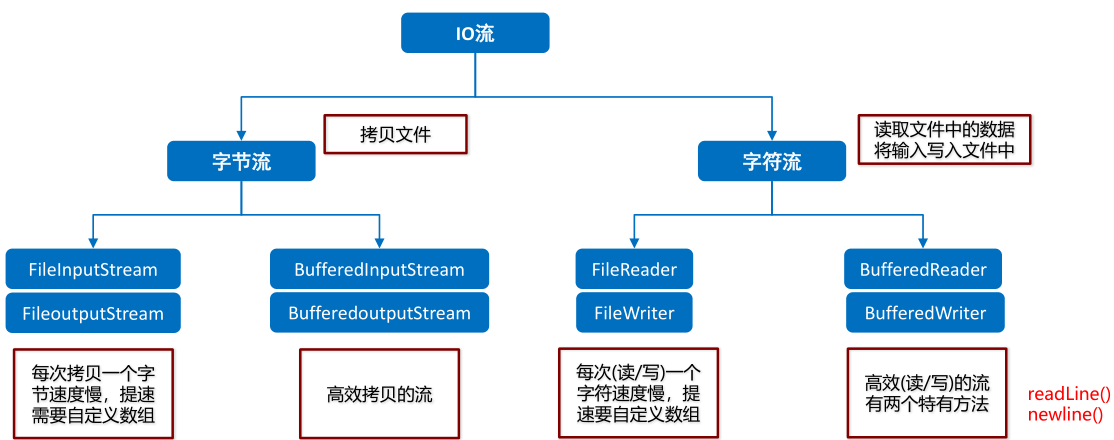

InputStreamReader:是从字节流到字符流的桥梁,父类是Reader
? 它读取字节,并使用指定的编码将其解码为字符
? 它使用的字符集可以由名称指定,也可以被明确指定,或者可以接受平台的默认字符集
OutputStreamWriter:是从字符流到字节流的桥梁,父类是Writer
? 是从字符流到字节流的桥梁,使用指定的编码将写入的字符编码为字节
? 它使用的字符集可以由名称指定,也可以被明确指定,或者可以接受平台的默认字符集
构造方法
| 方法名 | 说明 |
|---|---|
| InputStreamReader(InputStream in) | 使用默认字符编码创建InputStreamReader对象 |
| InputStreamReader(InputStream in,String chatset) | 使用指定的字符编码创建InputStreamReader对象 |
| OutputStreamWriter(OutputStream out) | 使用默认字符编码创建OutputStreamWriter对象 |
| OutputStreamWriter(OutputStream out,String charset) | 使用指定的字符编码创建OutputStreamWriter对象 |
代码演示
public class ConversionStreamDemo {
public static void main(String[] args) throws IOException {
//OutputStreamWriter osw = new OutputStreamWriter(new FileOutputStream("myCharStream\\osw.txt"));
OutputStreamWriter osw = new OutputStreamWriter(new FileOutputStream("myCharStream\\osw.txt"),"GBK");
osw.write("中国");
osw.close();
//InputStreamReader isr = new InputStreamReader(new FileInputStream("myCharStream\\osw.txt"));
InputStreamReader isr = new InputStreamReader(new FileInputStream("myCharStream\\osw.txt"),"GBK");
//一次读取一个字符数据
int ch;
while ((ch=isr.read())!=-1) {
System.out.print((char)ch);
}
isr.close();
}
}

FileReader fr = new FileReader("D:\\file\\a.txt",Charset.forName("gbk"));
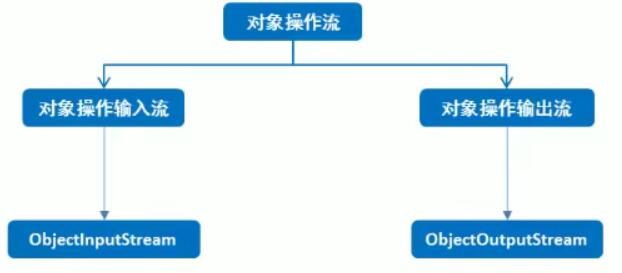
对象序列化介绍
对象序列化流: ObjectOutputStream
构造方法
| 方法名 | 说明 |
|---|---|
| ObjectOutputStream(OutputStream out) | 创建一个写入指定的OutputStream的ObjectOutputStream |
序列化对象的方法
| 方法名 | 说明 |
|---|---|
| void writeObject(Object obj) | 将指定的对象写入ObjectOutputStream |
示例代码
学生类
//如果想要这个类的对象能被序列化,那么这个类必须要实现一个接口.Serializable
//Serializable 接口的意义
//称之为是一个标记性接口,里面没有任何的抽象方法
//只要一个类实现了这个Serializable接口,那么就表示这个类的对象可以被序列化.
public class Student implements Serializable {
private String name;
private int age;
public Student() {
}
public Student(String name, int age) {
this.name = name;
this.age = age;
}
public String getName() {
return name;
}
public void setName(String name) {
this.name = name;
}
public int getAge() {
return age;
}
public void setAge(int age) {
this.age = age;
}
@Override
public String toString() {
return "Student{" +
"name=‘" + name + ‘\‘‘ +
", age=" + age +
‘}‘;
}
}
测试类
public class ObjectOutputStreamDemo {
public static void main(String[] args) throws IOException {
//ObjectOutputStream(OutputStream out):创建一个写入指定的OutputStream的ObjectOutputStream
ObjectOutputStream oos = new ObjectOutputStream(new FileOutputStream("myOtherStream\\oos.txt"));
//创建对象
Student s = new Student("佟丽娅",30);
//void writeObject(Object obj):将指定的对象写入ObjectOutputStream
oos.writeObject(s);
//释放资源
oos.close();
}
}
注意事项
对象反序列化流: ObjectInputStream
构造方法
| 方法名 | 说明 |
|---|---|
| ObjectInputStream(InputStream in) | 创建从指定的InputStream读取的ObjectInputStream |
反序列化对象的方法
| 方法名 | 说明 |
|---|---|
| Object readObject() | 从ObjectInputStream读取一个对象 |
示例代码
public class ObjectInputStreamDemo {
public static void main(String[] args) throws IOException, ClassNotFoundException {
//ObjectInputStream(InputStream in):创建从指定的InputStream读取的ObjectInputStream
ObjectInputStream ois = new ObjectInputStream(new FileInputStream("myOtherStream\\oos.txt"));
//Object readObject():从ObjectInputStream读取一个对象
Object obj = ois.readObject();
Student s = (Student) obj;
System.out.println(s.getName() + "," + s.getAge());
ois.close();
}
}
serialVersionUID
transient
示例代码
学生类
public class Student implements Serializable {
//serialVersionUID 序列号
//如果我们自己没有定义,那么虚拟机会根据类中的信息会自动的计算出一个序列号.
//问题:如果我们修改了类中的信息.那么虚拟机会再次计算出一个序列号.
//第一步:把User对象序列化到本地. --- -5824992206458892149
//第二步:修改了javabean类. 导致 --- 类中的序列号 4900133124572371851
//第三步:把文件中的对象读到内存. 本地中的序列号和类中的序列号不一致了.
//解决?
//不让虚拟机帮我们自动计算,我们自己手动给出.而且这个值不要变.
private static final long serialVersionUID = 42L;
private String name;
// private int age;
private transient int age;
public Student() {
}
public Student(String name, int age) {
this.name = name;
this.age = age;
}
public String getName() {
return name;
}
public void setName(String name) {
this.name = name;
}
public int getAge() {
return age;
}
public void setAge(int age) {
this.age = age;
}
// @Override
// public String toString() {
// return "Student{" +
// "name=‘" + name + ‘\‘‘ +
// ", age=" + age +
// ‘}‘;
// }
}
测试类
public class ObjectStreamDemo {
public static void main(String[] args) throws IOException, ClassNotFoundException {
// write();
read();
}
//反序列化
private static void read() throws IOException, ClassNotFoundException {
ObjectInputStream ois = new ObjectInputStream(new FileInputStream("myOtherStream\\oos.txt"));
Object obj = ois.readObject();
Student s = (Student) obj;
System.out.println(s.getName() + "," + s.getAge());
ois.close();
}
//序列化
private static void write() throws IOException {
ObjectOutputStream oos = new ObjectOutputStream(new FileOutputStream("myOtherStream\\oos.txt"));
Student s = new Student("佟丽娅", 30);
oos.writeObject(s);
oos.close();
}
}
案例需求
创建多个学生类对象写到文件中,再次读取到内存中
实现步骤
代码实现
学生类
public class Student implements Serializable{
private static final long serialVersionUID = 2L;
private String name;
private int age;
public Student() {
}
public Student(String name, int age) {
this.name = name;
this.age = age;
}
public String getName() {
return name;
}
public void setName(String name) {
this.name = name;
}
public int getAge() {
return age;
}
public void setAge(int age) {
this.age = age;
}
}
测试类
第一种方法(死循环)
public static void main(String[] args) throws Exception {
ObjectOutputStream oos = new ObjectOutputStream(new FileOutputStream("g.txt"));
Person p1 = new Person("zhangsan",12);
Person p2 = new Person("lisi",14);
Person p3 = new Person("wangwu",13);
oos.writeObject(p1);
oos.writeObject(p2);
oos.writeObject(p3);
oos.close();
ObjectInputStream ois = new ObjectInputStream(new FileInputStream("g.txt"));
while (true){
try {
Person p = (Person)ois.readObject();
System.out.println(p);
} catch (Exception e) {
break;
}
}
}
第二种方法(对象放入集合)
public class Demo03 {
/**
* read():
* 读取到文件末尾返回值是 -1
* readLine():
* 读取到文件的末尾返回值 null
* readObject():
* 读取到文件的末尾 直接抛出异常
* 如果要序列化的对象有多个,不建议直接将多个对象序列化到文件中,因为反序列化时容易出异常
* 建议: 将要序列化的多个对象存储到集合中,然后将集合序列化到文件中
*/
public static void main(String[] args) throws Exception {
/*// 序列化
//1.创建序列化流对象
ObjectOutputStream oos = new ObjectOutputStream(new FileOutputStream("myCode\\oos.txt"));
ArrayList<Student> arrayList = new ArrayList<>();
//2.创建多个学生对象
Student s = new Student("佟丽娅",30);
Student s01 = new Student("佟丽娅",30);
//3.将学生对象添加到集合中
arrayList.add(s);
arrayList.add(s01);
//4.将集合对象序列化到文件中
oos.writeObject(arrayList);
oos.close();*/
// 反序列化
//5.创建反序列化流对象
ObjectInputStream ois = new ObjectInputStream(new FileInputStream("myCode\\oos.txt"));
//6.将文件中的对象数据,读取到内存中
Object obj = ois.readObject();
ArrayList<Student> arrayList = (ArrayList<Student>)obj;
ois.close();
for (Student s : arrayList) {
System.out.println(s.getName() + "," + s.getAge());
}
}
}
Properties介绍
Properties基本使用
public class PropertiesDemo01 {
public static void main(String[] args) {
//创建集合对象
// Properties<String,String> prop = new Properties<String,String>(); //错误
Properties prop = new Properties();
//增
prop.put("itcast001", "佟丽娅");
prop.put("itcast002", "赵丽颖");
prop.put("itcast003", "刘诗诗");
//删
prop.remove("itcast001");
//改: put 如果键不存在就添加,如果存在就覆盖原值
prop.put("itcast002","赵本山");
//查
Object value = prop.get("itcast003");
//遍历集合
Set<Object> keySet = prop.keySet();
for (Object key : keySet) {
Object value = prop.get(key);
System.out.println(key + "," + value);
}
}
}
特有方法
| 方法名 | 说明 |
|---|---|
| Object setProperty(String key, String value) | 设置集合的键和值,都是String类型,底层调用 Hashtable方法 put |
| String getProperty(String key) | 使用此属性列表中指定的键搜索属性 |
| Set |
从该属性列表中返回一个不可修改的键集,其中键及其对应的值是字符串 |
示例代码
public class PropertiesDemo02 {
public static void main(String[] args) {
//创建集合对象
Properties prop = new Properties();
//Object setProperty(String key, String value):设置集合的键和值,都是String类型
prop.setProperty("itcast001", "佟丽娅");
prop.setProperty("itcast002", "赵丽颖");
prop.setProperty("itcast003", "刘诗诗");
//String getProperty(String key):使用此属性列表中指定的键搜索属性
// System.out.println(prop.getProperty("itcast001"));
// System.out.println(prop.getProperty("itcast0011"));
// System.out.println(prop);
//Set<String> stringPropertyNames():从该属性列表中返回一个不可修改的键集,其中键及其对应的值是字符串
Set<String> names = prop.stringPropertyNames();
for (String key : names) {
// System.out.println(key);
String value = prop.getProperty(key);
System.out.println(key + "," + value);
}
}
}
和IO流结合的方法
| 方法名 | 说明 |
|---|---|
| void load(Reader reader) | 从输入字符流读取属性列表(键和元素对) |
| void store(Writer writer, String comments) | 将此属性列表(键和元素对)写入此 Properties表中,以适合使用 load(Reader)方法的格式写入输出字符流,comments就是注释信息 |
示例代码
public class PropertiesDemo03 {
public static void main(String[] args) throws IOException {
//把集合中的数据保存到文件
// myStore();
//把文件中的数据加载到集合
myLoad();
}
private static void myLoad() throws IOException {
Properties prop = new Properties();
//void load(Reader reader):
FileReader fr = new FileReader("myOtherStream\\fw.txt");
prop.load(fr);
fr.close();
System.out.println(prop);
}
private static void myStore() throws IOException {
Properties prop = new Properties();
prop.setProperty("itcast001","佟丽娅");
prop.setProperty("itcast002","赵丽颖");
prop.setProperty("itcast003","刘诗诗");
//void store(Writer writer, String comments):
FileWriter fw = new FileWriter("myOtherStream\\fw.txt");
prop.store(fw,null);
fw.close();
}
}
案例需求
在Properties文件中手动写上姓名和年龄,读取到集合中,将该数据封装成学生对象,写到本地文件
实现步骤
代码实现
学生类
public class Student implements Serializable {
private static final long serialVersionUID = 1L;
private String name;
private int age;
public Student() {
}
public Student(String name, int age) {
this.name = name;
this.age = age;
}
public String getName() {
return name;
}
public void setName(String name) {
this.name = name;
}
public int getAge() {
return age;
}
public void setAge(int age) {
this.age = age;
}
@Override
public String toString() {
return "Student{" +
"name=‘" + name + ‘\‘‘ +
", age=" + age +
‘}‘;
}
}
测试类
public class Test {
public static void main(String[] args) throws IOException {
//1.创建Properties集合,将本地文件中的数据加载到集合中
Properties prop = new Properties();
FileReader fr = new FileReader("prop.properties");
prop.load(fr);
fr.close();
//2.获取集合中的键值对数据,封装到学生对象中
String name = prop.getProperty("name");
int age = Integer.parseInt(prop.getProperty("age"));
Student s = new Student(name,age);
//3.创建序列化流对象,将学生对象序列化到本地文件中
ObjectOutputStream oos = new ObjectOutputStream(new FileOutputStream("a.txt"));
oos.writeObject(s);
oos.close();
}
}
原文:https://www.cnblogs.com/gonghr/p/15001250.html